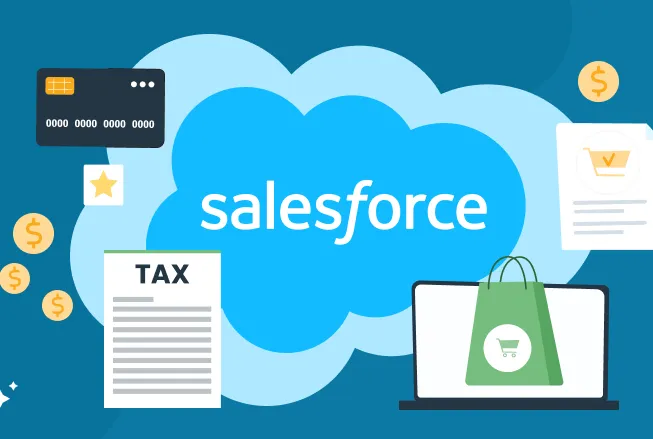
Introduction
I assume that every person reading this article made at least one online purchase. It doesn’t matter if you are buying or selling online, it’s all ecommerce. However, ecommerce works not only with desktop computers. Mobile devices are actually where most ecommerce activity takes place. Thanks to smartphones and the ease of shopping online, mobile commerce sales now account for nearly 70% of the total ecommerce market. This means that almost three-quarters of online purchases are made via mobile devices.
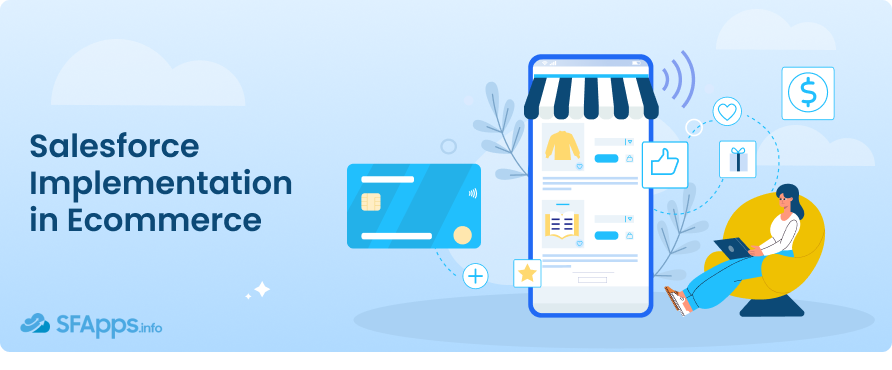
Ecommerce has become essential for retailers, moving beyond being just a luxury. Salesforce has merged its Commerce systems, B2C (previously Salesforce ecommerce Demandware) and B2B ecommerce Salesforce (formerly CloudCraze), into a single platform. This ecommerce integration Salesforce offers several advantages like a unified customer base and shared CMS components. Salesforce Commerce Cloud, formerly Demandware, becomes a guiding force in this change, leading businesses toward digital success. This journey from traditional to digital commerce has not been just about transposing physical stores online; it has evolved into crafting immersive and personalized customer experiences.
In this article we will explore the following topics:
- Overview of Salesforce Implementation in Ecommerce
- Sub-niches in the Salesforce Ecommerce Industry
- Main Steps in Salesforce Integration with Ecommerce
- Cost of Salesforce for Ecommerce Implementation
- Popular Salesforce Apps for Ecommerce
- Case Studies of Ecommerce Salesforce Integration
- FAQs about Salesforce Implementation in Ecommerce
- Does Salesforce Commerce Cloud function as a Content Management System?
- Can Salesforce eCommerce Cloud be classified as a SaaS or a PaaS?
- How do Salesforce Sales Cloud and Salesforce Commerce Cloud differ?
- Does Salesforce Commerce Cloud have an open-source framework?
- How to use Salesforce for eCommerce?
Overview of Salesforce Implementation in Ecommerce
The Salesforce Commerce Cloud’s ecommerce data model is integral to its functionality in ecommerce. It unifies customer and order data to create a connected, personalized buying experience across various touchpoints like marketing, sales, and service. This unified approach is crucial for businesses and consumers alike, emphasizing the importance of experience alongside products and services.
Industry-Specific Applications
- Healthcare and Life Sciences: Commerce Cloud enables healthcare organizations to launch HIPAA-compliant storefronts and streamline post-purchase processes. This includes real-time inventory management and easy order modifications, crucial for medical technology and pharmaceutical companies.
- Manufacturing: The platform aids manufacturing companies in modernizing operations and reducing costs. It offers self-service purchasing, subscription management, and a common data model for both B2B and direct-to-consumer (D2C) cases. This also improves fulfillment and order servicing, offering omni-channel experiences connected across commerce, service, and marketing.
- Consumer Packaged Goods (CPG): For CPG companies, Commerce Cloud helps in personalizing D2C and B2B channels, supporting various promotion types, and providing merchandising tools. It also helps in reducing fulfillment costs and enhancing customer service by centralizing order data for efficient tracking and servicing.
- Technology Industry: The platform assists tech companies in adapting to market shifts by automating selling and streamlining operations. This includes opening new self-service buying channels and driving customer loyalty through subscriptions, increasing cart sizes, and ensuring recurring revenue.
Sub-niches in the Salesforce Ecommerce Industry
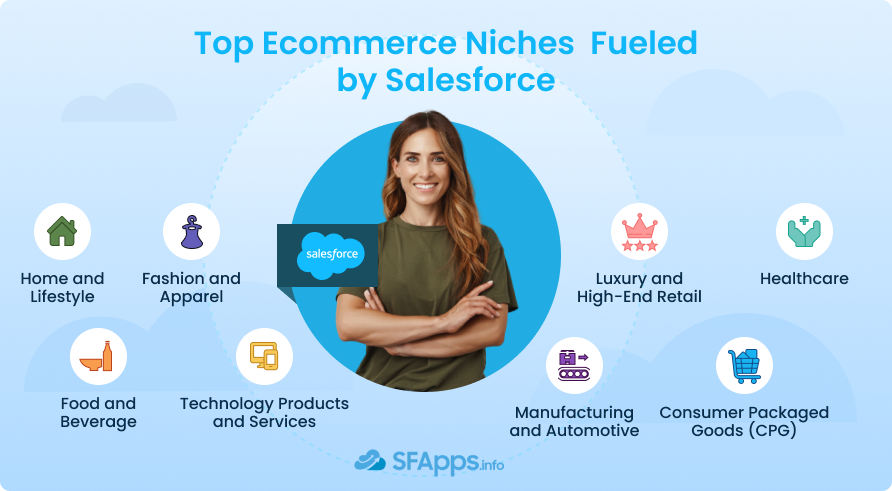
Salesforce implementation in ecommerce is not a one-size-fits-all solution. Different sub-niches within the ecommerce industry can benefit uniquely from Salesforce’s capabilities. Here are some sub-niches where Salesforce particularly shines:
- Luxury and High-End Retail: Brands in this segment can use Salesforce to create exclusive, personalized shopping experiences, leveraging tools for targeted marketing and customer loyalty.
- Healthcare Ecommerce: For online stores selling healthcare products, Salesforce offers HIPAA-compliant solutions and efficient order management to handle sensitive medical supplies and devices.
- Manufacturing and Automotive Ecommerce: Salesforce aids these sectors in streamlining operations, reducing costs, and providing efficient fulfillment services, especially for B2B transactions and D2C sales.
- Consumer Packaged Goods (CPG): Salesforce helps CPG companies personalize D2C and B2B channels, manage promotions, and reduce fulfillment costs while expanding their digital sales channels.
- Technology Products and Services: For tech companies, Salesforce streamlines operations through self-service buying channels and drives customer loyalty with subscription services.
- Fashion and Apparel: Salesforce’s customization and real-time data capabilities are ideal for fashion ecommerce, where trends and customer preferences change rapidly.
- Home and Lifestyle: For home and lifestyle ecommerce, Salesforce can enhance customer experience with personalized product recommendations and efficient order processing.
- Food and Beverage: In this niche, Salesforce can optimize supply chain management and provide insights into consumer buying patterns.
Each subniche can leverage Salesforce’s tools like CRM, AI-driven analytics, and marketing automation to enhance customer experience, streamline operations, and drive growth. Salesforce’s adaptability allows it to cater to the specific needs of these diverse ecommerce sub-niches, making it a versatile and powerful tool in the digital retail landscape.
Main Steps in Salesforce Integration With Ecommerce
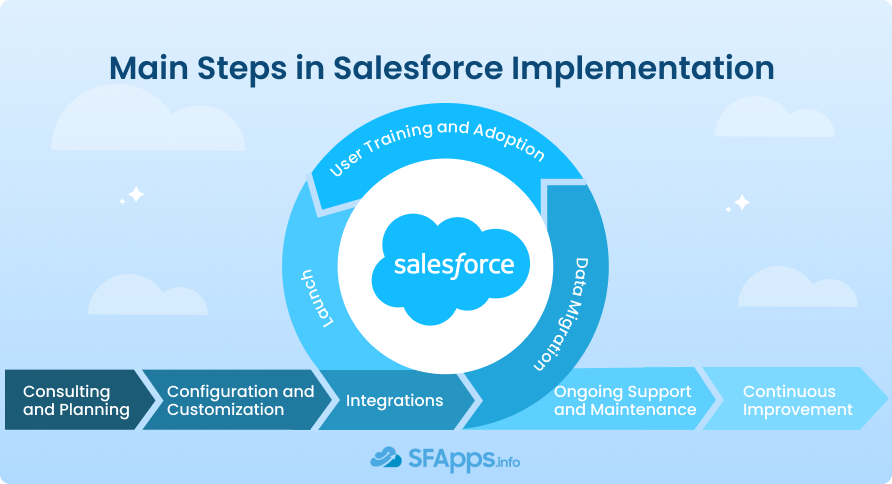
Implementing Salesforce in an ecommerce environment involves a comprehensive process tailored to meet specific business needs. Here’s an overview of the steps involved:
- Consulting and Planning: This initial phase involves understanding the business’s unique requirements, objectives, and challenges. The focus is on analyzing how Salesforce can help achieve these goals. Strategic planning includes deciding on necessary integrations, customizations, and budget considerations.
- Configuration and Customization: Based on the business’s specific needs, Salesforce is tailored accordingly. This step involves modifying the default capabilities of Salesforce and, if necessary, developing custom functionalities. It’s important to balance the business’s requirements with the feasibility and cost of custom development.
- Integrations: A critical step is integrating Salesforce with the existing software ecosystem, which may include ecommerce platforms, ERP solutions, payment gateways, and other tools. This ensures seamless data exchange and operational efficiency.
- Data Migration: Migrating existing data to Salesforce is crucial for continuity and accuracy. This step must be managed carefully to prevent data loss and system downtimes.
- User Training and Adoption: Successful implementation isn’t just about technology; it’s also about people. Training programs are essential to ensure that users across the organization can effectively utilize Salesforce. This involves familiarizing them with the platform’s features and custom functionalities.
- Launch: Once the system is fully tested and approved in a development environment, it’s launched in the user acceptance testing environment. After successful testing and final approvals, the system goes live for everyday use.
- Ongoing Support and Maintenance: Post-launch, regular monitoring of system performance is crucial. This includes addressing issues, introducing updates, and making enhancements based on user feedback.
- Continuous Improvement: Ecommerce is a dynamic field. Regular assessments, staying updated with platform updates, and adapting to industry trends are essential for maintaining efficacy and relevance.
Cost of Salesforce for Ecommerce Implementation
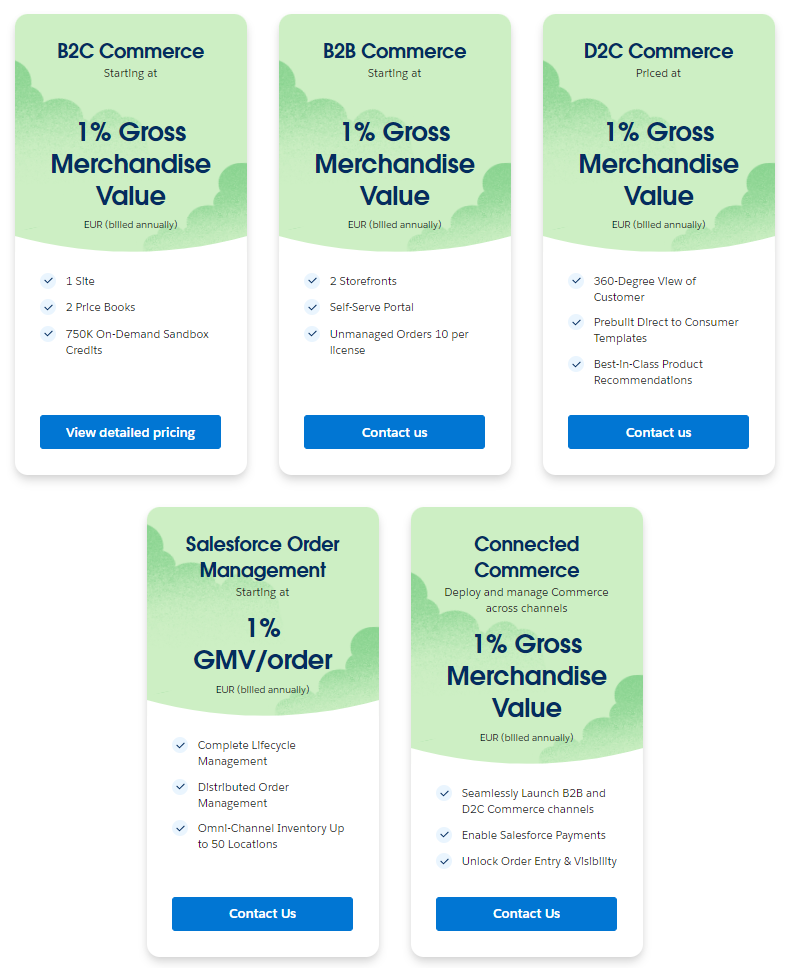
Image Source: Salesforce Products Commerce Pricing
The cost of implementing ecommerce in Salesforce varies significantly depending on several factors including company size, the complexity of implementation, and the level of customization required. Here’s a breakdown of different Salesforce Commerce Cloud packages:
- B2C Commerce: This package is generally aimed at businesses that sell directly to consumers. It includes features like a single site and price books. The Salesforce ecommerce pricing often starts at 1% of the Gross Merchandise Value (GMV), billed annually.
- Salesforce ecommerce B2B: This package is tailored for businesses selling to other businesses. It includes functionalities like multiple storefronts, a self-serve portal, and the ability to handle a certain number of unmanaged orders per license. The cost typically also starts at 1% of GMV.
- D2C Commerce: This offering is for businesses that want a direct-to-consumer approach and includes a 360-degree view of the customer, prebuilt templates, and product recommendations. Pricing is usually at 1% of GMV.
- Salesforce Order Management: This service provides complete lifecycle management, distributed order management, and omnichannel inventory up to a specific number of locations. The starting price is often at 1% of GMV per order.
- Connected Commerce: This service provides tools for managing commerce across various channels, with features that support seamless Salesforce B2B ecommerce and D2C channel launches, Salesforce Payments, and enhanced order entry and visibility. It’s also typically priced at 1% of GMV.
These offerings reflect Salesforce’s tiered pricing strategy, where costs are aligned with the volume of business conducted through their platform, making it scalable for businesses of different sizes and types. The specifics can vary based on the region, additional services, and the exact contractual agreement between Salesforce and the business.
Popular Salesforce Apps for Ecommerce
In the online retail, the strategic use of certain Salesforce applications can substantially uplift the customer journey, optimize business operations, and bolster sales growth. All Salesforce Ecommerce Solutions presented below live on AppExchange Salesforce Marketplace. More information about Salesforce AppExchange can be found in Sales Analytics App.
Sales Engagement: Groove
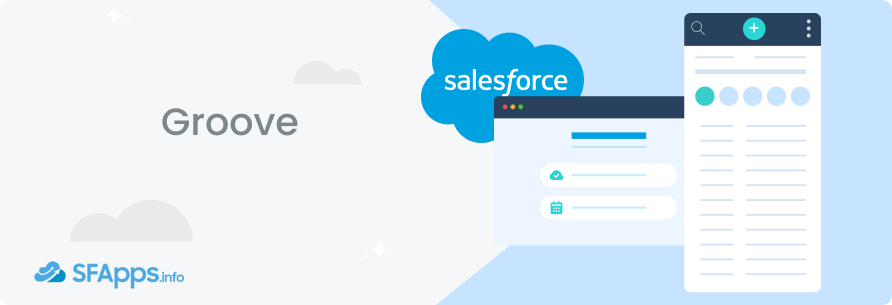
Groove stands out as a leading app in Salesforce’s ecosystem for sales engagement, offering tools to execute smart and flexible strategies to bolster sales performance. It provides automation, email tracking, analytics, and seamless Salesforce syncing, enabling sellers to communicate more effectively with prospects and customers to boost revenue. In case if you want to create a forecasting report with Salesforce, all details how-to can be found in Revenue Forecasting Salesforce.
Email and Calendar Salesforce Ecommerce Integration: Cirrus Insight
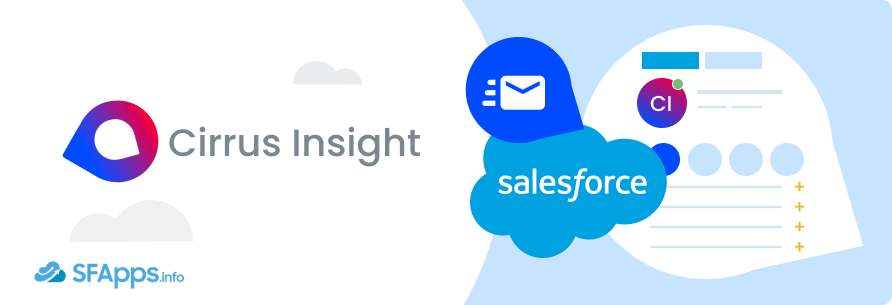
Cirrus Insight bridges the gap between Salesforce and personal information management services like Gmail and Outlook. This app centralizes CRM-related tasks by allowing users to manage contacts, calendar events, and track campaign success directly from their inbox, enhancing the efficiency of sales teams.
Sales Enablement: Dooly
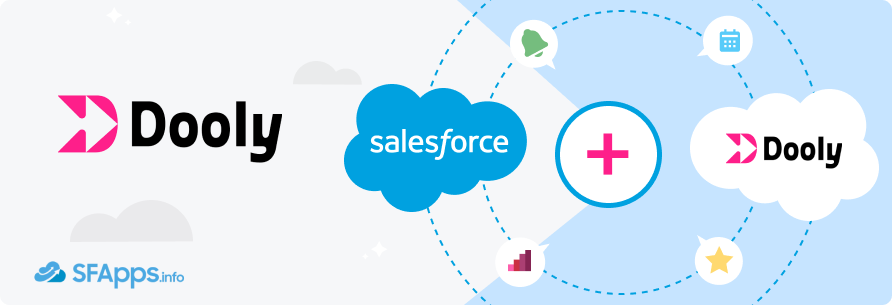
Dooly shines as a sales enablement tool, offering note-taking and collaboration features that sync with Salesforce in real-time. It aids sales professionals in planning and executing calls with discovery call templates and other sales tools, facilitating improved communication and deal closures.
B2B Sales Intelligence: ZoomInfo SalesOS
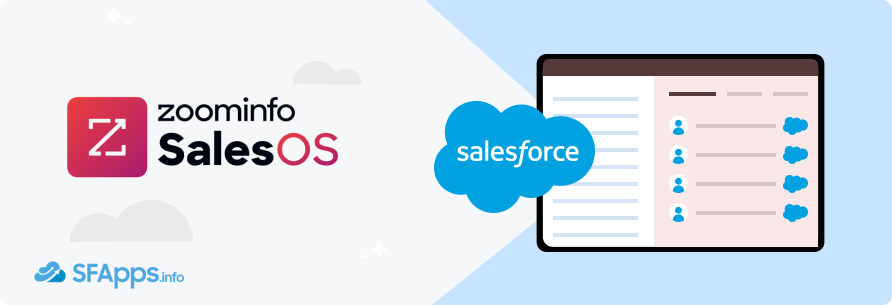
ZoomInfo SalesOS provides a comprehensive B2B marketing app with a global database of business contacts, sales intelligence, and automation tools. It helps users find the right leads, accelerate sales pipelines, and enhances productivity with up-to-date contact information.
Sales Engagement and Content Management: PandaDoc

Apps like PandaDoc offer a seamless integration within Salesforce that enhance document flow and management. It provides a robust solution for creating, sending, and tracking important sales documents directly within the CRM. With PandaDoc, Salesforce ecommerce businesses can automate their document processes, utilize electronic signatures for faster deal closures, and access a wealth of templates for a variety of business needs. This tool helps in simplifying the sales cycle and empowers teams to close deals with greater speed and efficiency, thus enhancing the overall customer engagement experience.
Each of these apps brings a unique set of features designed to optimize various aspects of ecommerce, from customer interaction to backend sales processes. They enable businesses to provide better service, gain insights into customer behavior, and ultimately drive growth. When choosing Salesforce apps, consider the specific needs of your business and how each app can meet those needs to enhance your ecommerce operations.
Case Studies of Ecommerce Salesforce Integration
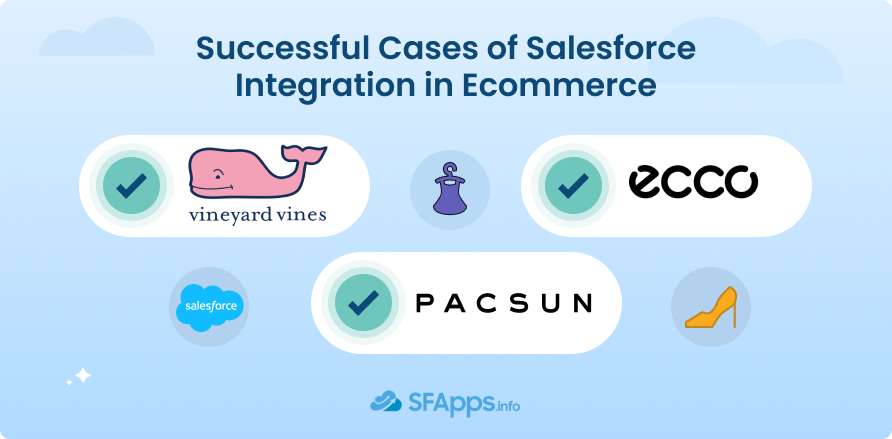
Numerous well-known brands have adopted Ecommerce Cloud Salesforce for their e commerce Salesforce operations, recognizing its ability to streamline and enhance the online shopping experience. Salesforce Commerce Cloud offers a range of Salesforce ecommerce solutions and features that help these brands manage their digital storefronts more effectively, integrate various sales channels, and provide a more personalized customer experience. The success stories of these implementations reflect the Salesforce ecommerce platform’s robust capabilities in addressing the unique needs of diverse ecommerce businesses.
PacSun:
PacSun has innovatively integrated social media with its ecommerce Salesforce strategy, transforming the shopping experience into something memorable and engaging for its customers. This approach leverages the power of social media platforms to enhance the online shopping journey, creating a more interactive and personalized experience. By doing so, PacSun aims to deepen customer engagement and foster a stronger connection between its brand and its audience.
Vineyard Vines:
Vineyard Vines has successfully enhanced its business growth and revenue by adopting a new omnichannel strategy. This strategic shift allows the brand to offer a more cohesive and integrated shopping experience across various channels, effectively blending online and offline customer interactions. This approach not only streamlines the customer journey but also significantly contributes to the brand’s overall growth and financial performance.
Ecco:
ECCO has enhanced its sales performance by implementing Salesforce Commerce Cloud’s Endless. This innovative approach expands their product offering beyond what is available in physical stores, thereby providing customers with a wider range of choices and improving the overall shopping experience. As a result, ECCO has seen a significant increase in sales closures, demonstrating the effectiveness of integrating digital solutions into traditional retail models.
FAQs about Salesforce Implementation in Ecommerce
Does Salesforce Commerce Cloud function as a Content Management System?
Salesforce Commerce Cloud includes a content management system (CMS) that facilitates the creation, management, and delivery of digital content across various channels. It is designed as a hybrid, headless CMS, allowing for content creation in one place with synchronization across digital touchpoints. With tools like Commerce Page Designer and Experience Builder, it enables unique customer experiences by allowing users to easily drag and drop content components. This CMS is API-first and integrates natively with Salesforce CRM, enhancing the ecommerce capabilities by providing a centralized Salesforce ecommerce platform for content across all customer interaction points.
Can Salesforce eCommerce Cloud be classified as a SaaS or a PaaS?
Salesforce Commerce Cloud encompasses both SaaS (Software as a Service) and PaaS (Platform as a Service) elements in its structure. This dualistic approach enhances its utility and adaptability for businesses. As a SaaS, it offers a ready-to-use ecommerce platform with essential features and managed services. Meanwhile, its PaaS aspect allows companies to customize and extend their ecommerce applications, granting them the flexibility to tailor solutions to their specific needs and the ability to scale and evolve in the dynamic business landscape. This combination makes Salesforce Commerce Cloud a versatile choice for diverse ecommerce requirements.
How do Salesforce Sales Cloud and Salesforce Commerce Cloud differ?
Salesforce Sales Cloud and Commerce Cloud serve different purposes within the Salesforce ecosystem. Sales Cloud is a CRM (Customer Relationship Management) platform designed primarily for sales teams. It focuses on managing customer information, tracking sales leads, automating sales processes, and providing analytics and reporting tools to optimize sales activities.
On the other hand, Commerce Cloud is specifically tailored for creating seamless, unified ecommerce experiences. It’s used for managing online storefronts, integrating customer shopping experiences across various digital channels, and includes features for ecommerce, such as catalog management, merchandising, and customer engagement.
In essence, while Sales Cloud is centered around managing and analyzing customer interactions and sales processes, Commerce Cloud is focused on the ecommerce aspect, facilitating businesses to engage with customers in the online shopping environment.
Does Salesforce Commerce Cloud have an open-source framework?
No, Salesforce Commerce Cloud is not an open-source platform. It is a proprietary software provided by Salesforce e commerce, operating on a SaaS (Software as a Service) model. This means that while businesses can use Salesforce Commerce Cloud to build and manage their ecommerce operations, they do not have access to its source code for modification or distribution, as is typical with open-source software. Salesforce Commerce Cloud provides a comprehensive set of tools and services for ecommerce management, but it does so within a controlled, licensed environment managed by Salesforce.
How to Use Salesforce for eCommerce?
Using Salesforce Commerce Cloud for ecommerce can benefit businesses in multiple ways:
- Unified Customer Experience: It integrates various shopping channels, providing a consistent experience across web, mobile, social, and in-store interactions.
- Personalization: Leveraging AI, the platform offers personalized shopping experiences, increasing engagement and sales.
- Global Reach with Localized Experiences: Supports global expansion with multi-language and multi-currency features while maintaining localized experiences.
- Efficient Management: Streamlines operations from inventory management to customer service, improving overall efficiency.
- Data-Driven Insights: Offers valuable analytics and insights for informed decision-making and strategy optimization.
- Scalability and Flexibility: Adapts and scales to meet changing business and market demands, suitable for businesses of all sizes.
These features make Salesforce Commerce Cloud a comprehensive solution for modern ecommerce challenges. For a more comprehensive understanding of Salesforce in retail, please check Sales Cloud Implementation Guide.
In Conclusion,
Salesforce Cloud eCommerce significantly reshapes the ecommerce landscape, offering a unified platform that caters to both B2C and B2B markets. Unified Salesforce and ecommerce in one platform is a game-changer, providing businesses with a single, comprehensive solution that merges customer databases and CMS components. It’s particularly effective in diverse industries, such as healthcare, manufacturing, consumer packaged goods, and technology, each benefiting from its tailored capabilities.
For instance, healthcare sectors can leverage HIPAA-compliant solutions, while manufacturing benefits from streamlined operational processes. The platform’s ecommerce Salesforce integration of AI and data analytics drives personalized customer experiences and business insights. In the mobile-dominated ecommerce sphere, Salesforce Commerce Cloud’s focus on personalized, data-driven customer interactions is vital for enhancing engagement and driving sales.
This platform not only transitions businesses from traditional to digital commerce but also enriches the online shopping experience with immersive, customer-centric features.

Dorian is a 6X Certified Salesforce Developer and Administrator with a start in the IT world as a CRM Admin in 2020. Since diving into Salesforce in 2021 via Trailhead and Focus on Force, he has achieved a Ranger Rank, earned several Superbadges, and bagged certifications including the Salesforce Certified Administrator, Platform App Builder, Associate and Platform Developer I by 2023. In 2024 he also became Salesforce Certified AI Associate and earned Certified AI Specialist Certification in 2025. Dorian is very keen on continuous learning, always looks for fresh ways to improve his knowledge. He enjoys running, boxing, kickboxing and reading diverse kinds of books in his free time.


 Previous Post
Previous Post Next Post
Next Post